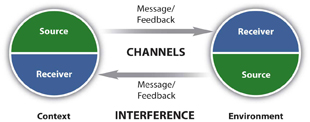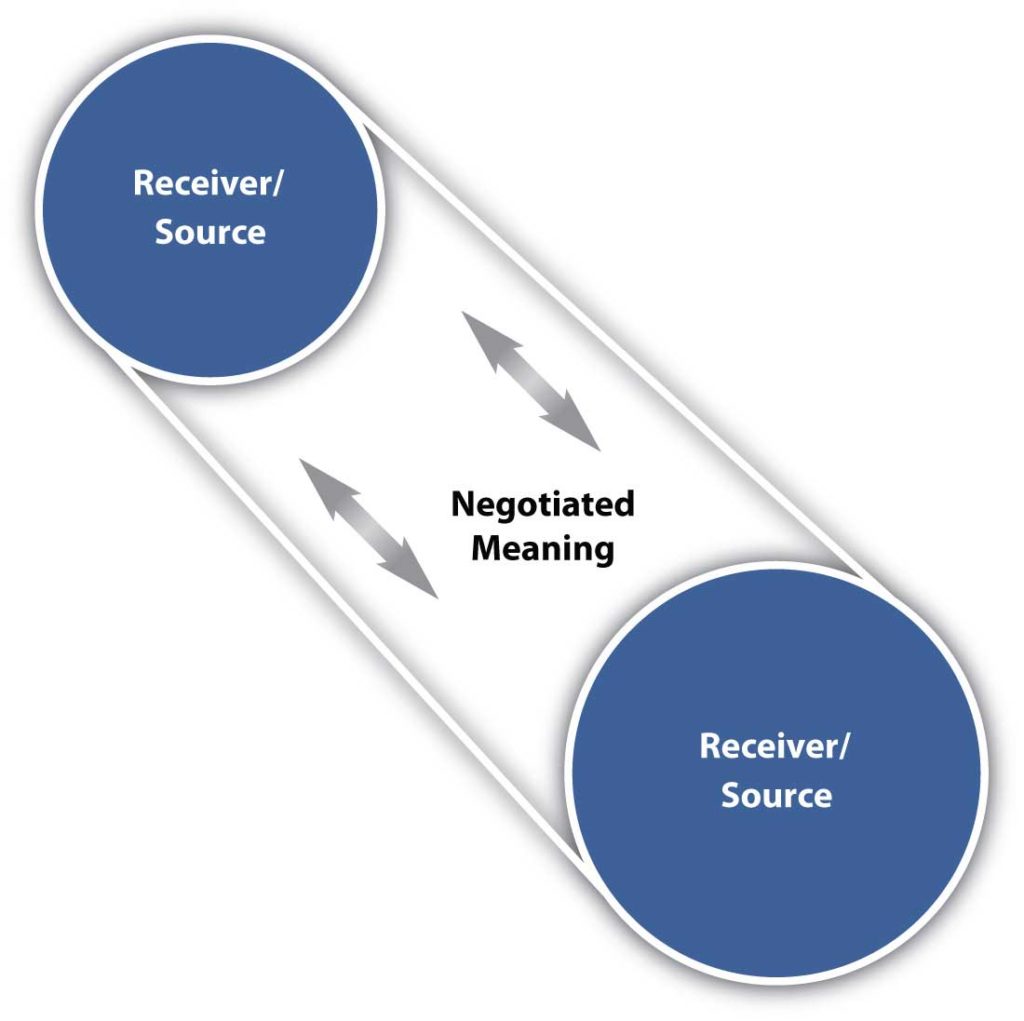Chapter 4: Communication
Two Models of Communication
Researchers have observed that when communication takes place, the source and the receiver may send messages at the same time, often overlapping. You, as the speaker, will often play both roles, as source and receiver. You’ll focus on the communication and the reception of your messages to the audience. The audience will respond in the form of feedback that will give you important clues. While there are many models of communication, here we will focus on two that offer perspectives and lessons for business communicators.
Rather than looking at the source sending a message and someone receiving it as two distinct acts, researchers often view communication as a transactional process (Figure 1.3 “Transactional Model of Communication”), with actions often happening at the same time. The distinction between source and receiver is blurred in conversational turn-taking, for example, where both participants play both roles simultaneously.
Figure 1.3 Transactional Model of Communication

Researchers have also examined the idea that we all construct our own interpretations of the message. As the State Department quote at the beginning of this chapter indicates, what I said and what you heard may be different. In the constructivist model (Figure 1.4 “Constructivist Model of Communication”), we focus on the negotiated meaning, or common ground, when trying to describe communication (Pearce & Cronen, 1980),
Imagine that you are visiting Atlanta, Georgia, and go to a restaurant for dinner. When asked if you want a “Coke,” you may reply, “sure.” The waiter may then ask you again, “what kind?” and you may reply, “Coke is fine.” The waiter then may ask a third time, “what kind of soft drink would you like?” The misunderstanding in this example is that in Atlanta, the home of the Coca-Cola Company, most soft drinks are generically referred to as “Coke.” When you order a soft drink, you need to specify what type, even if you wish to order a beverage that is not a cola or not even made by the Coca-Cola Company. To someone from other regions of the United States, the words “pop,” “soda pop,” or “soda” may be the familiar way to refer to a soft drink; not necessarily the brand “Coke.” In this example, both you and the waiter understand the word “Coke,” but you each understand it to mean something different. In order to communicate, you must each realize what the term means to the other person, and establish common ground, in order to fully understand the request and provide an answer.
Figure 1.4 Constructivist Model of Communication

Because we carry the multiple meanings of words, gestures, and ideas within us, we can use a dictionary to guide us, but we will still need to negotiate meaning.
Key Takeaway
The communication process involves understanding, sharing, and meaning, and it consists of eight essential elements: source, message, channel, receiver, feedback, environment, context, and interference. Among the models of communication are the transactional process, in which actions happen simultaneously, and the constructivist model, which focuses on shared meaning.
Test your knowledge
References
Cronen, V., & Pearce, W. B. (1982). The coordinated management of meaning: A theory of communication. In F. E. Dance (Ed.), Human communication theory (pp. 61–89). New York, NY: Harper & Row.
Leavitt, H., & Mueller, R. (1951). Some effects of feedback on communication. Human Relations, 4, 401–410.
McLean, S. (2003). The basics of speech communication. Boston, MA: Allyn & Bacon.
McLean, S. (2005). The basics of interpersonal communication (p. 10). Boston, MA: Allyn & Bacon.
Pearce, W. B., & Cronen, V. (1980). Communication, action, and meaning: The creating of social realities. New York, NY: Praeger.
Pearson, J., & Nelson, P. (2000). An introduction to human communication: Understanding and sharing (p. 6). Boston, MA: McGraw-Hill.
Weekley, E. (1967). An etymological dictionary of modern English (Vol. 1, p. 338). New York, NY: Dover Publications.

